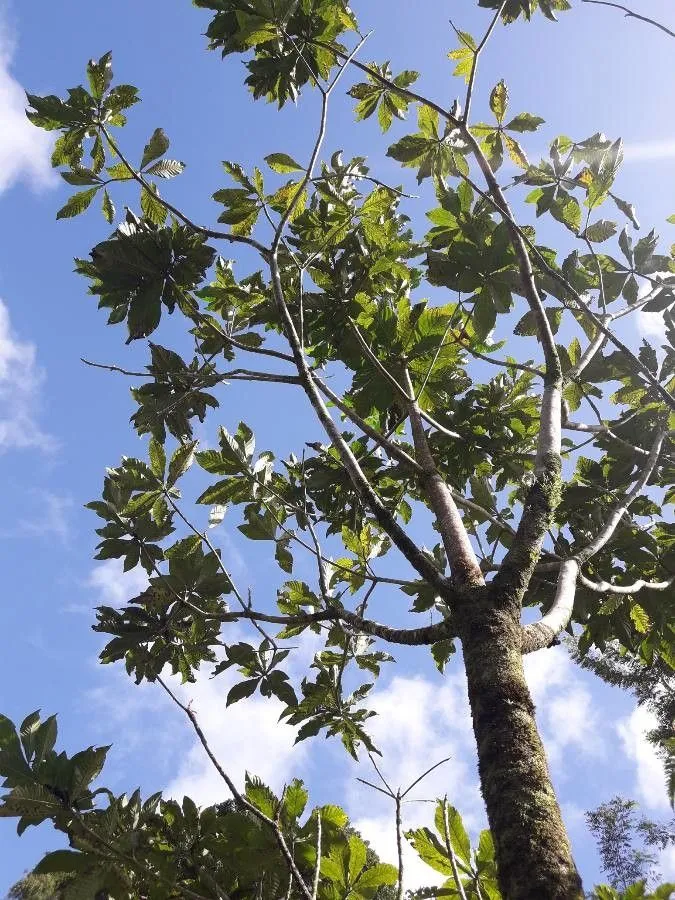
Author: L.
Bibliography: Syst. Nat. ed. 10, 2: 931 (1759)
Year: 1759
Status: accepted
Rank: species
Genus: Genipa
Vegetable: False
Observations: S. Mexico to Trop. America
Genip, known scientifically as Genipa americana, is an intriguing and versatile species belonging to the Rubiaceae family. This plant, which can be found from southern Mexico extending through to tropical regions of the Americas, has been documented in the renowned reference work “Syst. Nat. ed. 10, 2: 931” authored by L. in 1759.
Genipa americana is notable for its resilience and adaptability to various tropical environments. This perennial tree often stands out due to its significant ecological and cultural roles. The tree typically produces large, dark green leaves and is prized for its fruit, which has numerous applications ranging from culinary uses to traditional medicine. The fruit’s pulp is often consumed fresh, but it can also be processed into beverages, jams, and desserts.
The tree’s significance extends beyond its fruit. In traditional medicine, various parts of the genip have been utilized for their purported health benefits. For instance, infusions made from the leaves and bark are sometimes used to treat ailments such as digestive issues and skin conditions.
Ecologically, Genipa americana serves as an important source of nutrition for wildlife, while also playing a role in local ecosystems by contributing to the habitat’s diversity and stability. The tree’s flowers attract a variety of pollinators, promoting biodiversity in the regions where it is found.
Because of its broad range and the multitude of uses it offers, Genip is not only a plant of scientific interest but also one of great importance to the communities that have cultivated and used it throughout history. Its various applications underscore its value and the myriad roles it plays within both natural ecosystems and human societies.
In summary, Genipa americana or Genip, is a multifaceted tropical plant noted for its utility, ecological significance, and the rich cultural heritage associated with its use across its native range in the Americas.
Spa: caruto, genipa, huito, irayol, yagua, jenipapo, bi, bi-nané, caporán, guaitil, jagua
Fra: confiture de singe, génipa
Eng: genip, genipap, jagua, marmalade-box, marmalade, marmalade box
Swe: genipa
Por: genipapo, jenipapeiro
En: Genip, Genipap, Marmalade-box, Jagua, Marmalade box, Marmalade, Juniper, Marmeladebox
Ca: Huito
Zh: 靛欖
Fr: Génipa, Confiture de singe, Génipayer, Genipayer
De: Jenipapo
Gn: Ñandypa
He: ג’ניפה אמריקנה
Kv: Генипа
Ko: 제니팝나무
Fa: جنیپاپو
Pt: Genipapo, Jenipapeiro, Jeipapeiro, Mandipa, Yenipapa, Jenipapo
Qu: Wituq
Ru: Генипа
Es: Caruto, Genipa, Huito, Yagua, Irayol, Tapaculo, Guaitil., Jenipapo, Bi, Bi-nané, Caporán, Guaitil, Jagua, Bilito, Cafecillo denta, Caruto rebalsero, Guaricha, Guayatil colorado, Huitoc, Huitu, Jagua amarilla, Jagua blanca, Jagua colorado, Maluco, Nandipa, Totumillo, Guaitil Blanco, Guatil, Tabacón, Tapa Culo
Sv: Genipa
© copyright of the Board of Trustees of the Royal Botanic Gardens, Kew.
© copyright of the Board of Trustees of the Royal Botanic Gardens, Kew.
© copyright of the Board of Trustees of the Royal Botanic Gardens, Kew.
Taken Sep 12, 2022 by Alejandro Ospina (cc-by-sa)
Taken Dec 25, 2021 by Magnun Paula Pereira (cc-by-sa)
Taken Oct 22, 2021 by Soares Lopes Eduiges (cc-by-sa)
Taken Oct 22, 2021 by Soares Lopes Eduiges (cc-by-sa)
Taken May 8, 2022 by Moïse Niaux (cc-by-sa)
Taken Sep 17, 2019 by Dias Jr Oliveiros (cc-by-sa)
Taken May 8, 2022 by Moïse Niaux (cc-by-sa)
Taken Mar 5, 2022 by Kowal Dib Sara (cc-by-sa)
Taken Aug 4, 2021 by pedrogc — (cc-by-sa)
Taken Oct 12, 2022 by Carlos Tadeu (cc-by-sa)
Taken Nov 7, 2011 by AMAP Lab – Guyane 2022 (cc-by-sa)
Taken Nov 7, 2011 by AMAP Lab – Guyane 2022 (cc-by-sa)
Taken Nov 7, 2011 by AMAP Lab – Guyane 2022 (cc-by-sa)
Taken Nov 7, 2011 by AMAP Lab – Guyane 2022 (cc-by-sa)
Taken Nov 7, 2011 by AMAP Lab – Guyane 2022 (cc-by-sa)
Taken Apr 2, 2022 by Gomes Alex (cc-by-sa)
Taken Dec 26, 2019 by Silva Fernandes Virgílio César (cc-by-sa)
Taken Jan 25, 2017 by Alessandro Inácio (cc-by-sa)
Taken Aug 4, 2021 by pedrogc — (cc-by-sa)
Taken May 8, 2022 by Moïse Niaux (cc-by-sa)
Taken Jun 9, 2011 by OTS – Oviedo-Brenes, Federico (cc-by-nc-sa)
Taken Nov 21, 2021 by Gustavo Fiedler Rossi (cc-by-sa)
Taken Aug 12, 2021 by N C (cc-by-sa)
Taken Jun 16, 2019 by Formina Lara (cc-by-sa)
Taken Oct 27, 2020 by S Roy Choudhury (cc-by-sa)
Taken Apr 2, 2022 by Gomes Alex (cc-by-sa)
Taken Mar 4, 2021 by Sébastien TRASBOT (cc-by-sa)
Taken Mar 4, 2021 by Sébastien TRASBOT (cc-by-sa)
Taken Oct 22, 2021 by Soares Lopes Eduiges (cc-by-sa)
Taken May 8, 2022 by Moïse Niaux (cc-by-sa)
Growth habit: Tree
Family: Myrtaceae Author: (F.Muell.) K.D.Hill & L.A.S.Johnson Bibliography: Telopea 6: 402 (1995) Year: 1995 Status:…
Family: Rubiaceae Author: Pierre ex A.Froehner Bibliography: Notizbl. Bot. Gart. Berlin-Dahlem 1: 237 (1897) Year:…
Family: Sapindaceae Author: Koidz. Bibliography: J. Coll. Sci. Imp. Univ. Tokyo 32(1): 38 (1911) Year:…
Family: Asteraceae Author: A.Gray Bibliography: Pacif. Railr. Rep.: 107 (1857) Year: 1857 Status: accepted Rank:…
Family: Fabaceae Author: Medik. Bibliography: Vorles. Churpfälz. Phys.-Ökon. Ges. 2: 398 (1787) Year: 1787 Status:…
Family: Aspleniaceae Author: (Cav.) Alston Bibliography: Bull. Misc. Inform. Kew 1932: 309 (1932) Year: 1932…